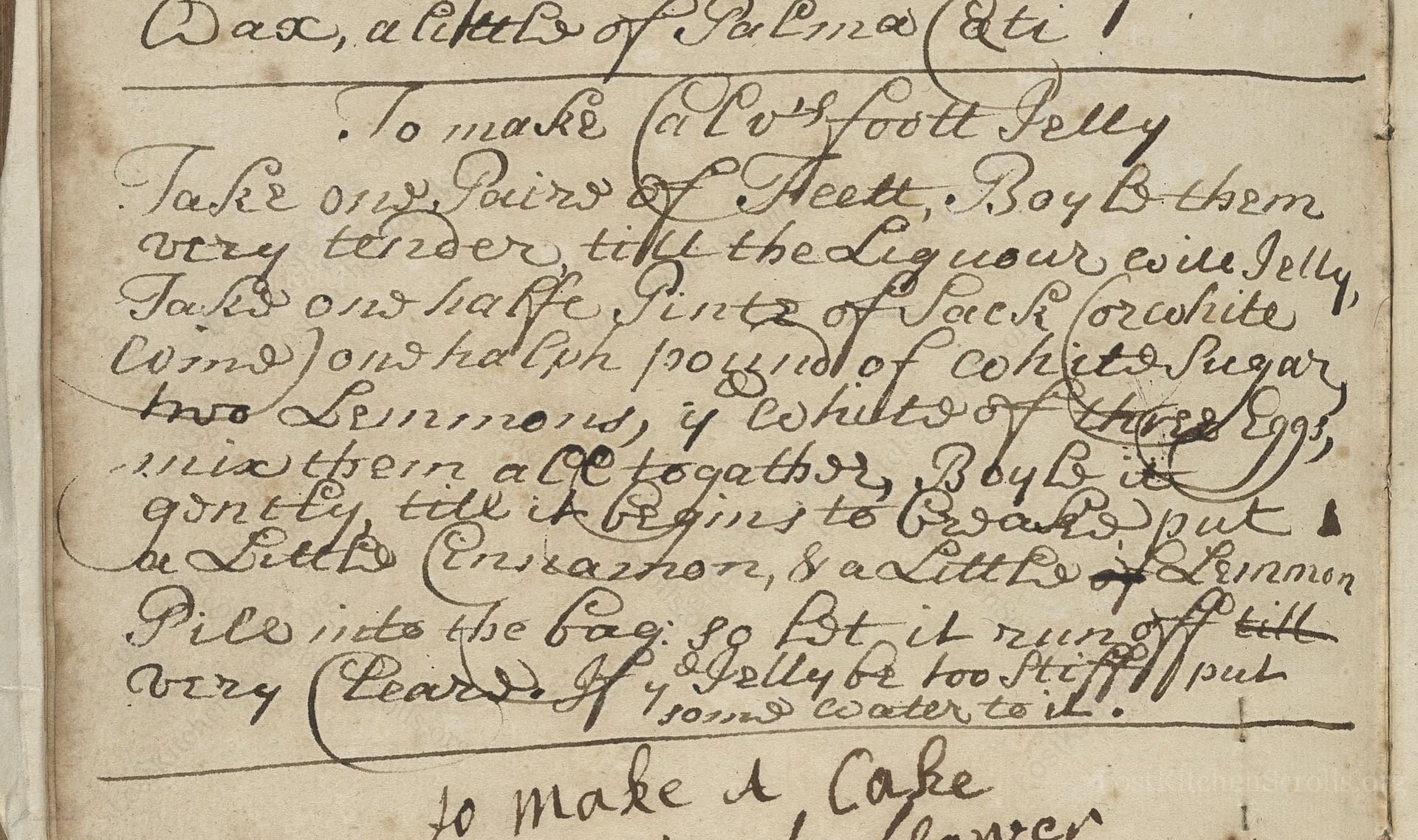To Make Calf'S Foott Jelly
From the treasured pages of Receipt book by Beulah Hutson
Written by Beulah Hutson

To Make Calf'S Foott Jelly
"Take one paire of Veall, Boyl them very tender, till the Liquour will Jelly. Take one halfe Pint of Sack (or white Wine) one halfe a pound of white Sugar, two Lemmons, & whites of three Eggs, mix them all together, Boyl it gently, till it begins to Braake. put a little Cinamon, & a little of Lemmon Peill into the bag. & Let it run off till very Cleare. If it Jellye too stiff, put some water to it."
Note on the Original Text
Recipes of this era were typically written for readers already well-versed in kitchen arts; hence, explicit measurements and temperatures are sparse or absent. Spelling varies ('boyl' for boil, 'liquour' for liquor or liquid, 'jellye' for jelly), reflecting the flexible orthography of the time. Directions are sequential but assume intuitive knowledge, such as knowing when a liquid 'will jelly.' The method for clarification—using egg white and acid—remains a classic, though described only in brief, as was the standard for the period.

Title
Receipt book by Beulah Hutson (1680)
You can also click the book image above to peruse the original tome
Writer
Beulah Hutson
Era
1680
Publisher
Unknown
Background
A delightful journey into 17th-century kitchens, this manuscript stirs together rustic recipes and culinary secrets, inviting readers to savor the ingenious flavors of Beulah Hutson's time.
Kindly made available by
Folger Shakespeare Library
This recipe hails from the English household manuscript tradition, circa 1680, at a time when jellied dishes were much admired for their clarity, shimmering beauty, and supposed restorative properties. Calf's foot jelly served as both dessert and medicinal food, often recommended for the invalid or as a delicacy during festive gatherings. It showcases sophisticated techniques for extraction and clarification, reflecting the culinary ambitions of well-to-do 17th-century households. Site and recipe attributions like 'V.a.684' are archival shelf-marks from historical collections, ensuring these culinary treasures are not lost to time.

In the late 17th century, cooks would have used large copper or iron pots over open hearths to simmer the feet, along with muslin or linen jelly bags for straining and clarifying the jelly. Mortars and pestles would be on hand for grinding spice, and simple ceramic molds would be used for setting the finished jelly. Wooden spoons and tongs aided the careful skimming and transfer of ingredients.
Prep Time
30 mins
Cook Time
5 hrs
Servings
8
We've done our best to adapt this historical recipe for modern kitchens, but some details may still need refinement. We warmly welcome feedback from fellow cooks and culinary historians — your insights support the entire community!
Ingredients
- 2 calves' feet or 4½ lbs veal feet (can substitute with 4½ lbs beef shinbones with skin for gelatin-rich stock)
- 3 quarts water
- 1 cup white wine or dry sherry
- 1 cup white sugar
- 2 lemons (juice and zest)
- 3 egg whites
- 1 small cinnamon stick
- Peel from 1 lemon
Instructions
- To craft a Calf's Foot Jelly in your own kitchen, begin by obtaining about 2 young veal or calf's feet (roughly 4½ lbs).
- Clean and cut into manageable pieces.
- Place them in a large pot and cover with about 3 quarts of cold water.
- Bring to a boil, skimming off any scum, then simmer gently for several hours (at least 4–5 hours) until the liquid is thick and gelatinous.
- Strain the broth through muslin to clarify it.
- In a separate bowl, lightly beat the whites of 3 eggs.
- Combine these with 1 cup of dry sherry or white wine, 1 cup of white sugar, and the zest and juice of 2 lemons.
- Add this mixture to the strained broth, whisk it in, and then return it to a clean pot.
- Bring the mixture back to a simmer, adding a small piece of cinnamon stick and a strip of lemon peel (from one of the lemons).
- Allow to simmer gently, then strain again through a jelly bag or fine muslin until beautifully clear.
- If your jelly sets too firmly, adjust with a splash of hot water.
- Once clear and at the desired consistency, pour into molds to chill and set.
Estimated Calories
210 per serving
Cooking Estimates
Preparing and cooking calf's foot jelly takes time because you need to slowly simmer the feet for several hours to extract the gelatin. Preparation includes cleaning and cutting the feet, preparing other ingredients, and clarifying the broth. Each serving is based on a typical dessert portion, and calorie estimates include sugar and gelatin but may vary depending on the cut of meat used.
As noted above, we have made our best effort to translate and adapt this historical recipe for modern kitchens, taking into account ingredients nowadays, cooking techniques, measurements, and so on. However, historical recipes often contain assumptions that require interpretation.
We'd love for anyone to help improve these adaptations. Community contributions are highly welcome. If you have suggestions, corrections, or cooking tips based on your experience with this recipe, please share them below.
Join the Discussion
Rate This Recipe
Dietary Preference
Main Ingredients
Culinary Technique

Den Bockfisch In Einer Fleisch Suppen Zu Kochen
This recipe hails from a German manuscript cookbook compiled in 1696, a time whe...

Die Grieß Nudlen Zumachen
This recipe comes from a rather mysterious manuscript cookbook, penned anonymous...

Ein Boudain
This recipe comes from an anonymous German-language manuscript cookbook from 169...

Ein Gesaltzen Citroni
This recipe, dating from 1696, comes from an extensive anonymous German cookbook...
Browse our complete collection of time-honored recipes



